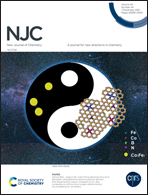C–H and C–C bond activation of propane to propylene and ethylene selectivity assisted by CO2 over titania catalysts†
Abstract
C–H and C–C bond dissociation over stable titania-based catalysts was studied for propane conversion assisted by CO2 to produce propylene and ethylene. The catalysts were characterised to determine their properties, and each catalyst exhibited a distinct surface acidity and bulk hydrogen reduction profile. The Zr/Ti oxide catalyst showed broader surface acidity, which resulted in higher C–H bond activation and promoted greater propylene selectivity in the range of 60%, and 20% ethylene selectivity. The Tl/Ti oxide catalyst favored the C–C bond dissociation mechanism of propane and achieved 55% ethylene selectivity, with 12% for propylene. CO2 promoted a longer life-cycle stream of catalytic conversion to propylene and ethylene yield compared with benchmark commercial catalysts. This study reveals the importance of titania-based catalysts to assist the C–H and C–C bond activation of propane over catalyst and demonstrated an alternative process to produce stable yields of propylene and ethylene.



 Please wait while we load your content...
Please wait while we load your content...